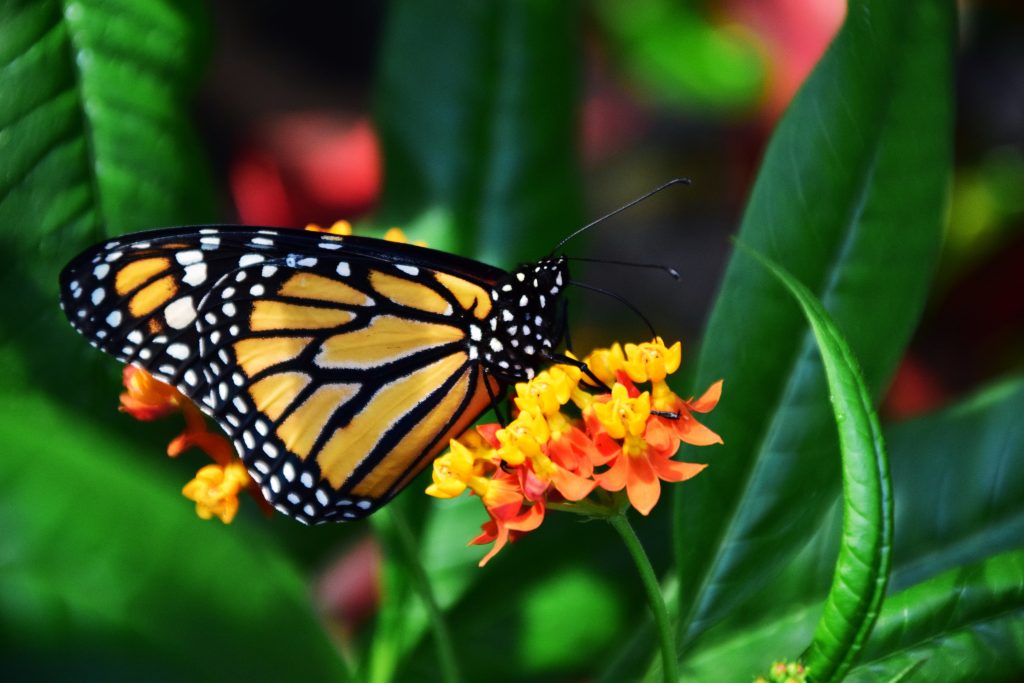Create a Butterfly Haven

Butterflies are so graceful and beautiful! They are also great pollinators. Unfortunately, they are rapidly declining in numbers. Creating a butterfly garden is a relatively easy way to help preserve the species. It’s fun, and it is a great activity for kids. Here’s how.
Select a sunny site that provides some shelter from wind. It is also good to keep it away from birdfeeders and birdbaths. (Birds love to eat caterpillars.) Then fill it with plants that they like.
Nectar Plants and Host Plants
Nectar plants are a primary food source for adult butterflies. Butterflies like brightly colored flowers that are flat topped with either clusters of small flowers, like lantana, or have a single set of petals, like cosmos. Some also like tubular flowers like salvia and agastache. Native plants and heirloom or old-fashioned varieties are often best. If you do choose hybrid varieties of flowers, try to keep to those whose shape doesn’t stray too far from their original form. Try annuals like tithonia, zinnia, marigolds, salvia, sweet alyssum, ageratum, petunias, and sunflowers in addition to lantana and cosmos. Perennials like Joe-Pye weed, aster, solidago, butterfly weed, milkweed, tall garden phlox, coneflower, black-eyed Susan, liatris, coreopsis, salvia, agastache, bee balm, and scabiosa are all great choices, too.
Host plants feed caterpillars and provide a place for laying eggs and transformation. Most types of butterflies have very specific needs and preferences, so if you are looking to attract a certain type of butterfly, you will want to look it up online to learn what they need. The good news is that many host plants for butterflies that live in our area are the plants that we commonly grow here. They include trees like birch, cottonwood, oak, locust, cherry, plum, and elm, and perennials and garden plants like milkweed, hollyhock, baptisia, dill, and blueberries. Weeds like clover and thistle also serve as host plants for some butterflies. The host plants in your garden will develop holes in leaves and often may not look perfect. If that bothers you, plant them in the back of your garden bed, or away from your deck or patio.
And of course, using pesticides and chemicals on your flowers will harm butterflies, birds, and other pollinators. A butterfly garden needs to be chemical free to be truly beneficial. Look for organic and natural pest solutions whenever possible.
Water, Warmth, and Shelter
In addition to food, butterflies also need water, warm spots for sunbathing, and shelter. Butterflies drink water, and get important minerals, from shallow puddles of sand and mud. You can create a puddling area by filling a shallow dish with sand, mix in a little compost or dirt, then regularly fill it with enough water to keep it moist, but not wet. Place the dish in a sunny spot near the flowers you planted and arrange a few rocks nearby as perches for sunbathing. Leaving a small patch of bare soil in a low-lying area will create a perfect puddle when as well.
Shelter is most easily provided by keeping a place in your yard or garden a little bit messy. Butterflies shelter tall in grasses or rock, brush, or log piles. They also hide in crevices of tree bark. You may see “butterfly houses” for sale online or in stores, but they may be of questionable benefit. Wasps seem to like them more than butterflies. Instead, plant some decorative grasses and trees, and give yourself permission to let that little brush pile sit in a corner of your yard. Then sit back and enjoy the show!
Even a small butterfly garden can be a big help. If you can’t do everything suggested on this list, that’s OK. Planting a just pot of flowers that provide nectar will help preserve the butterfly population. If you’d like help selecting flowers for your butterfly garden, please stop in one of our Pleasant Prairie Greenhouse locations. We are fully stocked with some great options, and we are open daily through June. To look at list of the plants we carry go to www.pleasantprairiegreenhouse.com and click on the link below the main photo on our home page.
